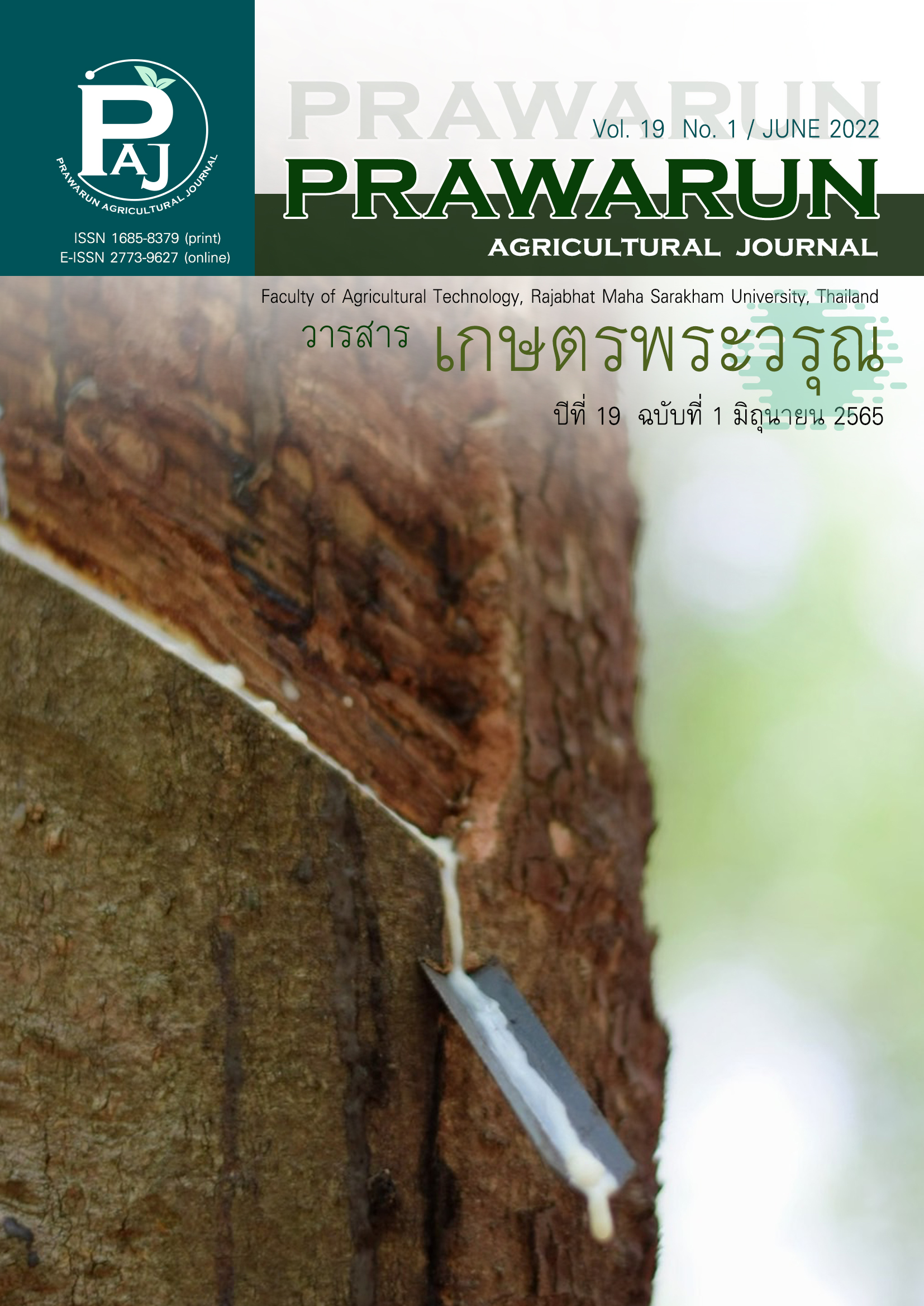ความชุกและปัจจัยที่มีผลต่อการติดพยาธิเม็ดเลือดในสุนัขที่เข้ารับการรักษา ณ โรงพยาบาลสัตว์เพื่อการเรียนการสอน คณะสัตวแพทยศาสตร์ มหาวิทยาลัยมหาสารคาม
Main Article Content
บทคัดย่อ
งานวิจัยนี้ศึกษาความชุกและปัจจัยที่มีผลต่อการติดพยาธิเม็ดเลือดในสุนัขที่เข้ารับการรักษา ณ โรงพยาบาลสัตว์เพื่อการเรียนการสอน คณะสัตวแพทยศาสตร์ มหาวิทยาลัยมหาสารคาม โดยใช้วิธีการเก็บตัวอย่างเลือดสุนัข จำนวน 529 ตัว ระหว่างเดือนมีนาคมถึงเดือนกรกฎาคม 2562 เตรียมตัวอย่างเลือดบนสไลด์และย้อมด้วยสีไรท์–จิมซ่า ตรวจภายใต้กล้องจุลทรรศน์แบบใช้แสง พบความชุกของสุนัขที่ติดเชื้อชนิดเดียวมากที่สุด คือ Ehrlichia canis ร้อยละ 35.92 และสุนัขที่ติดเชื้อมากกว่าหนึ่งชนิด คือ Anaplasma platys ร่วมกับ E. canis ร้อยละ 14.18 การศึกษาความชุกของเพศ สายพันธุ์ และอายุ พบว่า สุนัขเพศผู้ สุนัขสายพันธุ์ต่างประเทศและสุนัขที่มีอายุมากกว่าสามปีมีความชุกต่อการติดเชื้อมากที่สุด สำหรับการศึกษาปัจจัยที่มีผลต่อการติดพยาธิเม็ดเลือด ได้แก่ เพศ สายพันธุ์ และอายุ พบว่า สุนัขเพศผู้และเพศเมียไม่มีความแตกต่างทางสถิติต่อการติดพยาธิเม็ดเลือด ส่วนสุนัขสายพันธุ์ต่างประเทศและสุนัขอายุมากกว่าสามปีมีความเสี่ยงต่อการติดพยาธิเม็ดเลือดมากกว่ากลุ่มอื่น ๆ อย่างมีนัยสำคัญทางสถิติ (p < 0.05) จากการศึกษาครั้งนี้สามารถใช้เป็นข้อมูลพื้นฐานสำหรับเจ้าหน้าที่ห้องปฏิบัติการ การศึกษาเชิงระบาดวิทยา และการวิจัยในอนาคตต่อไป รวมถึงเป็นประโยชน์สำหรับผู้รักการเลี้ยงสุนัขโดยนำผลการศึกษาไปใช้ในการวางแผนการเลี้ยงดู นอกเหนือจากนั้น ยังเป็นประโยชน์ต่อการเลือกเพศและสายพันธุ์ตลอดจนการดูแลสุนัขในช่วงอายุต่าง ๆ อีกด้วย
Article Details
เอกสารอ้างอิง
Angelou, A., Gelsakis, A. I., Verde, N., Pantchev, M., Schaper. R., & Chandrashekar, R. (2019). Prevalence and risk factors for selected canine vector-borne diseases in Greece. Parasites Vectors, 12(1), 283. doi: 10.1186/s13071–019–3543–3
Anise, N. H., Toepp, A. J., Ugwu, C. A., Petersen, C. A., & Sykes, J. E. (2018). Detection and identification of blood–borne infections in dogs in Nigeria using light microscopy and the polymerase chain reaction. Veterinary parasitology, regional studies and reports, 11, 55–60.
Baneth, G., Barta, J. R., Shkap, V., Martin, D. S., Macintire, D. K., & Johnson, N. V. (2000). Genetic and antigenic evidence supports the separation of Hepatozoon canis and Hepatozoon americanum at the species level. Journal of Clinical Microbiology, 38(3), 1298–1301. doi: 10.1128/JCM.38.3.1298–1301.2000
Baneth, G., Samish, M., Alekseev, E., Aroch, I., & Shkap, V. (2001). Transmission of Hepatozoon canis to dogs by naturally–fed or percutaneously–injected Rhipicephalus sanguineus ticks. Journal of Parasitology, 87(3), 606–611. doi:10.1645/00223395(2001)087[0606:TOHCTD]2.0.CO;2
Baneth, G., Shkap, V., Presentey, B. Z., & Pipano, E. (1996). Hepatozoon canis: the prevalence of antibodies and gametocytes in dog Isreal. Veterinary Research Communications, 20, 41–46. doi: 10.1007/BF00346576
Ewing, S. A., Panciera, R. J., Mathew, J. S., Cummings, C. A., & Kocan, A. A. (2000). American canine hepatozoonosis. Annals of the New York Academy of Sciences, 916, 81–92. doi: 10.1111/j.1749–6632.2000.tb05277.x
Galay, R. L., Malano, A. A., Dolores, S. L., Aguilar I. P., Sandalo, K. A., Cruz, K. B., Divina, B. P., Andoh, M., Masatani , T., & Tanaka, T. (2018). Molecular detection of tick–borne pathogens in canine population and Rhipicephalus sanguineus (sensu lato) ticks from southern Metro Manila and Laguna, Philippines. Parasites & Vectors, 11(1), 643–650. doi: 10.1186/s13071–0183192–y
Gavazza, A., Bizzeti, M., & Papini, R. (2003). Observation on dogs found naturally infected with Hepatozoon canis in Italy. Revue de Medecine Veterinaire, 154(8–9), 319–323.
Jamnah, O., Chandrawathani, P., Premaalatha, B., Zaini, C. M., Sheikh, A. M. S. I., & Tharshini, J. (2016). Blood protozoa findings in pet dogs screened in IPOH, Malaysia. Malaysian Journal of Veterinary research, 7(1), 9–14.
Juasook, A,. Boonmars, T., Sriraj, P., & Aukkanimart, R. (2016). Prevalence of tick–borne pathogens in quarantined dogs at Nakornpranom animal quarantine station, Thailand. Journal of Mahanakorn Veterinary Medicine, 11(1), 1–9.
Laummaunwai, P., Sriraj, P., Aukkanimart, R., Boonmars, T., Wonkchalee, N., & Boonjaraspinyo, S. (2014). Molecular detection and treatment of tick–borne pathogens in domestic dogs in KhonKaen, Northeastern Thailand. The Southeast Asian Journal of Tropical Medicine and Public Health, 45(5), 1157–1166.
Obeta, S. S., Ibrahim, B., Lawal, I. A., Natala, J. A., Ogo, N, I., & Balogun E, O. (2020). Prevalence of canine babesiosis and their risk factors among asymptomatic dogs in the federal capital territory, Abuja, Nigeria. Parasite Epidemiology and control, 11, e00186. doi:10.1016/j.parepi.2020.e00186
Panciera, R. J., Ewing, S. A., Mathew, J. S., Lehenbauer, T. W., Cummings, C. A., & Woods, J. P. (1999). Canine hepatozoonosis: comparison of lesions and parasites in skeletal muscle of dogs experimentally or naturally infected with Hepatozoom americanum. Veterinary Parasitology, 82, 261–272. doi: 10.1016/s0304–4017(99)00029–1
Piratae, S., Pimjong, K., Vaisusuk, K., & Chantan, W. (2015). Molecular detection of Ehrlichia canis, Hepatozoon canis and Babesia canis vogeli in stray dogs in Mahasarakham province, Thailand. Annals of Parasitology, 61(3), 183–7. doi: 10.17420/ap6103.05.
Piratae, S. (2017). Molecular detection of blood pathogens and their impacts on levels of packed cell volume in stray dogs from Thailand. Asian Pacific Journal of Tropical Disease, 7(4), 233–2367. doi: 10.12980/apjtd.7.2017D6–370
Piratae, S., Senawong, P., Chalermchat, P., Harnarsa, W., & Sae–chue, B. (2019). Molecular evidence of Ehrlichia canis and Anaplasma platys and the association of infections with hematological responses in naturally infected dogs in Kalasin, Thailand. Veterinary world, 12(1), 131–135. doi:10.14202/vetworld.2019. 131–135
Rucksaken, R., Maneeruttanarungroj, C., Maswanna, T., Sussadee, M., & Kanbutra, P. (2019). Comparison of conventional polymerase chain reaction and routine blood smear for the detection of Babesia canis, Hepatozoon canis, Ehrlichia canis, and Anaplasma platys in Buriram province, Thailand. Veterinary World, 12(5), 700–705. doi: 10.14202/vetworld.2019. 700–705
Sanisuriwong, J., Juntuck, N., Pavastthipaisit, S., Boonsriroj, H., & Wiengcharoen, J. (2012). Prevalence of hemoparasite in dogs in Nongchok, Bangkok, Thailand. Journal of Mahanakorn Veterinary Medicine, 7(1), 25–35.
Shaw, S. E., Day, M. J., Birtles, R. J., & Breitschwerdt, E. B. (2001). Tick–borne infectious diseases of dogs. Trends in Parasitology, 17, 74–80. doi: 10.1016/s1471–4922(00)01856–0
Skotarczak, B. (2003). Canine ehrlichiosis. Annals of Agricultural and Environmental Medicine, 10(2), 137–141.
Suksawat, J., Xuejie, Y., Hancock, S. I., Hegarty, B. C., Nilkumhang, P., & Breitschwerdt, E. B. (2001). Serologic and molecular evidence of coinfection with multiple vector–borne pathogens in dogs from Thailand. Journal of Veterinary Internal Medicine, 15, 453–462. doi:10.1892/08916640(2001)015<0453:sameoc>2.3.co;2
Weeraathunga, D., Amarasinghe, A., Iddawela, D., & Wickramasinghe, S. (2019). Prevalence of canine tick–borne haemoparasited in three divisional secretariat divisions (Rambewa, Tirappane, and Galenbidunuwena) in the Anuradhapura district, Sri Lanka. Sri Lanka Journal of Infectious Diseases, 9(2), 111–119. doi: 10.4038/sljid.v9i2.8254
Wongsawang, W., & Jeimthaweeboon, S. (2019). Retrospective study of canine blood parasites infections in Kanchanaburi province during 2012–2016. Journal of animal health science and technology, 3(3), 32–42. (in Thai)


